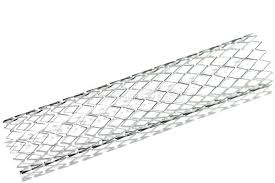Cardiac Stent
A stent is a small mesh tube that's used to treat narrow or weak arteries. Arteries are blood vessels that carry blood away from your heart to other parts of your body.
A stent is placed in an artery as part of a procedure called percutaneous coronary intervention (PCI), also known as coronary angioplasty. PCI restores blood flow through narrow or blocked arteries. A stent helps support the inner wall of the artery in the months or years after PCI.
Doctors also may place stents in weak arteries to improve blood flow and help prevent the arteries from bursting.
Stents usually are made of metal mesh, but sometimes they're made of fabric. Fabric stents, also called stent grafts, are used in larger arteries.
Some stents are coated with medicine that is slowly and continuously released into the artery. These stents are called drug-eluting stents. The medicine helps prevent the artery from becoming blocked again.
Doctors may use stents to treat coronary heart disease (CHD).
CHD is a disease in which a waxy substance called plaque builds up inside the coronary arteries. These arteries supply your heart muscle with oxygen-rich blood.
When plaque builds up in the arteries, the condition is called atherosclerosis.
Plaque narrows the coronary arteries, reducing the flow of oxygen-rich blood to your heart. This can lead to chest pain or discomfort called angina.
The buildup of plaque also makes it more likely that blood clots will form in your coronary arteries. If blood clots block a coronary artery, a heart attack will occur.
Doctors may use percutaneous coronary intervention (PCI), also known as coronary angioplasty, and stents to treat CHD. During PCI, a thin, flexible tube with a balloon or other device on the end is threaded through a blood vessel to the narrow or blocked coronary artery.
Once in place, the balloon is inflated to compress the plaque against the wall of the artery. This restores blood flow through the artery, which reduces angina and other CHD symptoms.
Unless an artery is too small, a stent usually is placed in the treated portion of the artery during PCI. The stent supports the artery's inner wall. It also reduces the chance that the artery will become narrow or blocked again. A stent also can support an artery that was torn or injured during PCI.
Even with a stent, there's about a 10–20 percent chance that an artery will become narrow or blocked again in the first year after PCI. When a stent isn't used, the risk can be as much as 10 times as high.
Research has shown that as time goes by, people who have coronary artery stents are in less danger of risks from the surgery but more prone to the risks of chronic diseases, such as type 2 diabetes and renal failure.
Reference:








